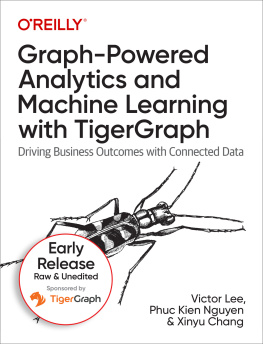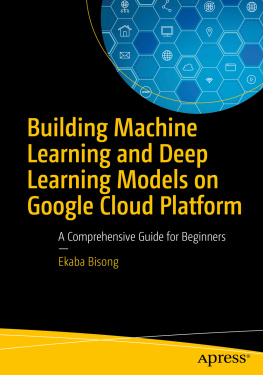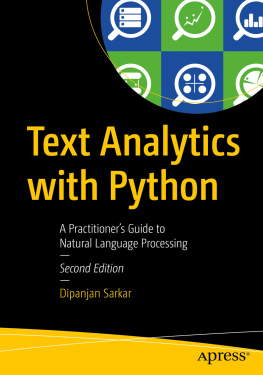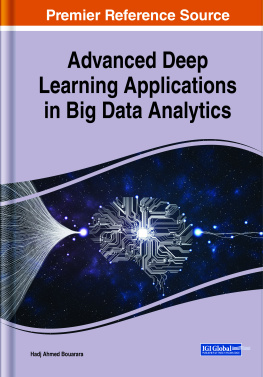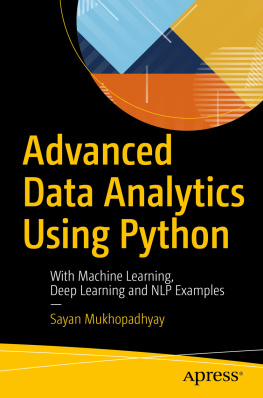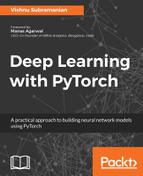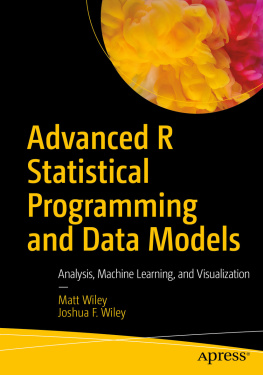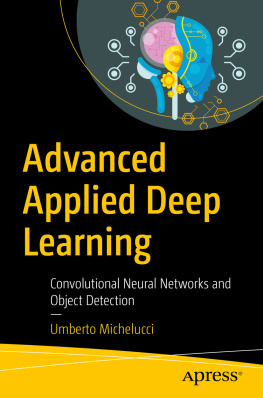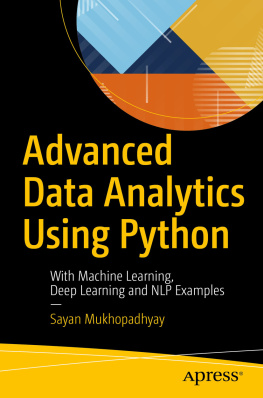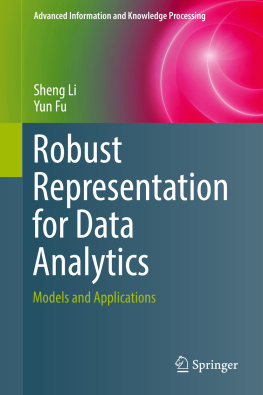Mire Archana - Advanced Analytics and Deep Learning Models
Here you can read online Mire Archana - Advanced Analytics and Deep Learning Models full text of the book (entire story) in english for free. Download pdf and epub, get meaning, cover and reviews about this ebook. year: 2022, genre: Home and family. Description of the work, (preface) as well as reviews are available. Best literature library LitArk.com created for fans of good reading and offers a wide selection of genres:
Romance novel
Science fiction
Adventure
Detective
Science
History
Home and family
Prose
Art
Politics
Computer
Non-fiction
Religion
Business
Children
Humor
Choose a favorite category and find really read worthwhile books. Enjoy immersion in the world of imagination, feel the emotions of the characters or learn something new for yourself, make an fascinating discovery.

- Book:Advanced Analytics and Deep Learning Models
- Author:
- Genre:
- Year:2022
- Rating:4 / 5
- Favourites:Add to favourites
- Your mark:
- 80
- 1
- 2
- 3
- 4
- 5
Advanced Analytics and Deep Learning Models: summary, description and annotation
We offer to read an annotation, description, summary or preface (depends on what the author of the book "Advanced Analytics and Deep Learning Models" wrote himself). If you haven't found the necessary information about the book — write in the comments, we will try to find it.
Advanced Analytics and Deep Learning Models — read online for free the complete book (whole text) full work
Below is the text of the book, divided by pages. System saving the place of the last page read, allows you to conveniently read the book "Advanced Analytics and Deep Learning Models" online for free, without having to search again every time where you left off. Put a bookmark, and you can go to the page where you finished reading at any time.
Font size:
Interval:
Bookmark:
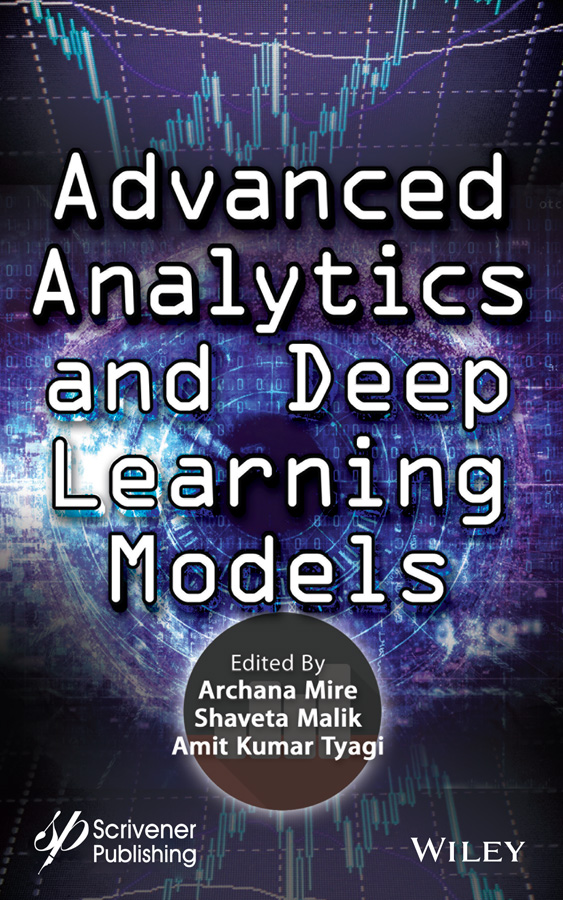
Scrivener Publishing
100 Cummings Center, Suite 541J
Beverly, MA 01915-6106
Next-Generation Computing and Communication Engineering
Series Editors: Dr. G. R. Kanagachidambaresan and Dr. Kolla Bhanu Prakash
Developments in artificial intelligence are made more challenging because the involvement of multi-domain technology creates new problems for researchers. Therefore, in order to help meet the challenge, this book series concentrates on next generation computing and communication methodologies involving smart and ambient environment design. It is an effective publishing platform for monographs, handbooks, and edited volumes on Industry 4.0, agriculture, smart city development, new computing and communication paradigms. Although the series mainly focuses on design, it also addresses analytics and investigation of industry-related real-time problems.
Publishers at Scrivener
Martin Scrivener ()
Phillip Carmical ()
Edited by
Archana Mire
Computer Engineering Department, Terna Engineering College, Navi Mumbai, India
Shaveta Malik
Computer Engineering Department, Terna Engineering College, Nerul, India
and
Amit Kumar Tyagi
Vellore Institute of Technology (VIT), Chennai Campus, India

This edition first published 2022 by John Wiley & Sons, Inc., 111 River Street, Hoboken, NJ 07030, USA and Scrivener Publishing LLC, 100 Cummings Center, Suite 541J, Beverly, MA 01915, USA
2022 Scrivener Publishing LLC
For more information about Scrivener publications please visit www.scrivenerpublishing.com.
All rights reserved. No part of this publication may be reproduced, stored in a retrieval system, or transmitted, in any form or by any means, electronic, mechanical, photocopying, recording, or otherwise, except as permitted by law. Advice on how to obtain permission to reuse material from this title is available at http://www.wiley.com/go/permissions.
Wiley Global Headquarters
111 River Street, Hoboken, NJ 07030, USA
For details of our global editorial offices, customer services, and more information about Wiley products visit us at www.wiley.com.
Limit of Liability/Disclaimer of Warranty
While the publisher and authors have used their best efforts in preparing this work, they make no representations or warranties with respect to the accuracy or completeness of the contents of this work and specifically disclaim all warranties, including without limitation any implied warranties of merchant-ability or fitness for a particular purpose. No warranty may be created or extended by sales representatives, written sales materials, or promotional statements for this work. The fact that an organization, website, or product is referred to in this work as a citation and/or potential source of further information does not mean that the publisher and authors endorse the information or services the organization, website, or product may provide or recommendations it may make. This work is sold with the understanding that the publisher is not engaged in rendering professional services. The advice and strategies contained herein may not be suitable for your situation. You should consult with a specialist where appropriate. Neither the publisher nor authors shall be liable for any loss of profit or any other commercial damages, including but not limited to special, incidental, consequential, or other damages. Further, readers should be aware that websites listed in this work may have changed or disappeared between when this work was written and when it is read.
Library of Congress Cataloging-in-Publication Data
ISBN 978-1-119-79175-1
Cover image: Pixabay.Com
Cover design by Russell Richardson
Set in size of 11pt and Minion Pro by Manila Typesetting Company, Makati, Philippines
Printed in the USA
10 9 8 7 6 5 4 3 2 1
Advanced analytics is a mixture of machine learning, artificial intelligence, graphs, text mining, data mining, semantic analysis. It is an approach to data analysis. Beyond the traditional business intelligence, it is a semi and autonomous analysis of data by using different techniques and tools. However, deep learning and data analysis both are the high centres of data science. Almost all the private and public organizations collect heavy amounts of data, i.e., domain specific data. Many small/large companies are exploring large amounts of data for existing and future technology. Deep learning is also exploring large amounts of unsupervised data.
In fact, it is a key benefit of big data. It is also effective for big data. Moreover, it is collecting an unlabelled and uncategorized raw data. There are some challenges also in big data related to the extraction complex patterns from the large amount of data, retrieving of fast information, tagging of data etc, deep learning can be used to deal these kinds of problems or challenges.
The purpose of this book is to help teachers to instruct the concepts of analytics in deep learning and how big data technologies are managing massive amounts of data with the help of Artificial Intelligence (AI), Machine Learning (ML), Deep Learning (DL) etc. In this book one will find the utility and challenges of big data. Those who are keen to learn the different models of deep learning, the connection between AI, ML and DL will definitely find this book as a great source of knowledge.
This book contains chapters on artificial intelligence, machine learning, deep learning and their uses in many useful sectors like stock market prediction, recommendation system for better service selection, ehealthcare, telemedicine, transportation. In last few interesting chapter like innovations or issue or future opportunities with fog computing/cloud computing or artificial intelligence are being discussed in this work for future readers/researchers.
Hence, this book will be convenient to the undergraduate and graduate students planning their careers in either industry or research. This will also serve as a great source of learning to software engineers who are beginners in the field of advanced analytics in deep learning.
Dr. Archana Mire
Dr. Shaveta Malik
Dr. Amit Kumar Tyagi
January 2022
INTRODUCTION TO COMPUTER VISION
Artificial Intelligence in Language Learning: Practices and Prospects
Khushboo Kuddus
School of Humanities (English), KIIT Deemed to be University, Bhubaneswar, Odisha, India
Abstract
Fourth Industrial Revolution which features rapid expansion of technology and digital application is influencing almost all spheres of our lives. Artificial Intelligence (AI) has made an impact on the way we live and work, that is, from floor cleaning to instructing Alexa. AI has a great potential in the field of education. AI in education is an emerging field in educational technology. It has an enormous potential of providing digitalized and completely personalized learning to each learner. However, the idea of using AI in education is actually intimidating educators because there is a lot of misconception and misunderstanding regarding the use of AI in education. It is mainly because the educators are unaware of the pedagogical implication of it in education in general and language learning in particular. It is also because of the lack of critical reviews of the pedagogical implications and new approaches in adopting AI in education. Therefore, the present study attempts to explore how AI can be used to enhance language learning experiences. It discusses the tools that can be used to teach English effectively. It further aims to explain how AI can be used to foster learners autonomy. It essentially envisions AI embedded learning in classrooms to enhance English language teaching learning experience and assist the teachers teach their lessons effectively. The findings bring into light some practical and innovative ways, AI can be integrated in ELT classroom to enhance the language teaching learning experience. It focuses on teaching pronunciation and increasing fluency by mimicking the sound pattern and using speech recognition and speech editing features. Moreover, it also highlights the personal approach to language learning by using Chatbot which provides text-to-speech and speech-to-text conversion, using technology to transcribe speech in order to check the pronunciation, translate speech, and practicing conversation by using voice command like Google Assistant. Hence, the paper examines the potential application of AI in education and language learning in particular. Further, it explores the possibilities of implication of AI in classrooms adopting new learning approaches and pedagogical modifications.
Next pageFont size:
Interval:
Bookmark:
Similar books «Advanced Analytics and Deep Learning Models»
Look at similar books to Advanced Analytics and Deep Learning Models. We have selected literature similar in name and meaning in the hope of providing readers with more options to find new, interesting, not yet read works.
Discussion, reviews of the book Advanced Analytics and Deep Learning Models and just readers' own opinions. Leave your comments, write what you think about the work, its meaning or the main characters. Specify what exactly you liked and what you didn't like, and why you think so.

